Did you know that bubble gum is pink because red dye was the only color available at the manufacturing facility and it diluted to pink? In 1928, Walter Diemer, the accountant for a chewing gum company in PA formulated this pink bubble gum that was less sticky and stretchier. He started a wave of bubble gum products after WWII from Bazooka to Hubba Bubba and Bubble Yum into the 1970s. If you haven’t tested the stretchiness of your bubble gum lately, maybe today is the day.Whether you take us up on our invitation or not, bankers surely like to stretch their dollars, especially customer service dollars. That’s why it’s useful for you to know that, even though both mobile messaging and web-based chat let you talk with customers, 48% of consumers would be happier with mobile messaging apps over web-based chat. Additionally, Aberdeen Research has shown that Net Promoter Scores are almost 3x higher for those companies that use messaging as part of their customer service. In order to keep customers satisfied, community financial institutions (CFIs) should consider whether this technology would be a valuable addition to your communication toolkit for quick questions and flexible interactions. Here are seven reasons why customers prefer mobile messaging.
- Asynchronous communication. Messaging apps have an important feature that chats don’t — they allow asynchronous communication. Chats happen when both the customer and the customer service staffer are in the electronic “room.” Messaging apps work more like email, with both sides responding when they’re able. That’s a much more convenient fit for customers’ busy lives. It also means that they never need to sit in front of a screen, waiting for a financial institution’s representative to be ready to help them.
- Untethered assistance. Instead of waiting for a customer service representative to respond to a query, messaging apps let customers go about their day. Chats force customers to stay on a single device, whether that’s a phone, laptop, or desktop computer. With a messaging app, a customer can start a conversation on a laptop, then continue it on a phone. The discussion is portable for the flexibility of the client.
- Searchable conversations. If a customer forgets exactly what was said in a conversation, a messaging app lets him go back and read it again. He can even search by topic or date. That means clients aren’t having duplicate conversations with your customer service workers, who are free to help other clients with new problems. Chats, on the other hand, disappear as soon as someone closes the chat window.
- No authentication needed. Chats often require a tedious authentication process, to ensure that the customer is who she says she is. Messaging apps don’t because app-based conversations happen behind a login page that handles the authentication. If the customer uses a messaging app on her phone, that phone’s biometric capabilities likely mean that her fingerprint is all the authentication she needs.
- More options. Chats let the customer and bank employee use letters and numbers to communicate. A messaging app opens the options well beyond those limits. On an app, a conversation can include images, video files, live video and voice, and even emojis. With richer content, conversations can be more detailed and complex — and there’s less chance of misunderstanding.
- Greater connections. Messaging apps foster richer conversations and support more personality in a message. Customers feel like they’re talking to a person rather than to a machine. Connecting more personally can help customer service agents add humor and care to conversations, depending on the situation, and strengthen client relationships.
- More assistance. A customer service agent can handle two to three chats at the same time. Because messaging apps are asynchronous, the same employee can manage 20 to 30 conversations at once. That means more customers can be helped.
While many CFIs may want to have both options available, it is important to know where your customers find the most value in order to get the best ROI. Mobile messaging apps provide flexibility and greater connections, among others, which go a long way in our busy world.




